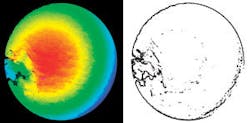Vision system checks drugs in three dimensions
Andrew Wilson, Editor, [email protected]
Ever aware of potential litigation should any of their products prove faulty, today’s pharmaceutical companies are deploying increasingly sophisticated machine-vision systems. Not only can these systems inspect the specific features of each drug such as its size, shape, and features, they can also be used to calculate the volume of the drug and any sophisticated drug delivery mechanism present.
“Many of today’s orally administered tablets use special coating designs to time-delay the delivery of the drug into the body,” says John Nagle, president of Nagle Research (Cedar Park, TX, USA; www.nagleresearch.com). With such delivery systems, it is imperative that the drug is properly coated and that the features are of the correct size, otherwise too much or too little of the drug will be released.
In addition to inspecting the delivery mechanisms associated with such medicines, it is equally important to check the surface features, whether any fracturing or breakage has occurred and whether any remnants have been left after the drug is pressed into shape. “Because drugs are manufactured in different colors, including some that are very dark, it is very difficult for conventional 2-D camera-based systems to detect these defects,” says Nagle. “Furthermore, because these systems cannot easily determine the depth of each tablet, any volume calculation presents a formidable task to the systems developer.”
To overcome these difficulties, Nagle and his colleagues have recently deployed a 3-D vision system at a major US pharmaceutical vendor. Capable of inspecting up to 250,000 tablets per hour, the PC-based system uses a structured laser from StockerYale (Montreal, QC, Canada; www.stockeryale.com) to illuminate a single line of tablets as they travel along a conveyor. With a linewidth as thin as 0.005 mm, this structured light is reflected into a Ranger E50 high-speed multiscan camera from SICK (Minneapolis, MN, USA; www.sick.com).
Because the camera views the laser line from a different angle, the camera effectively images the height profile of the tablets. By measuring the laser line deviations from a straight reference line, the height of the object can be computed. As the tablets move through the laser beam, contour slices or 3-D profiles are collected at a rate of up to 30,000 profiles/s and transferred to the host PC over Gigabit Ethernet.
“In some configurations where only the surface of the tablet needs to be measured,” says Nagle, “the use of a single camera is all that is required.” However, in situations where the complete tablet must be imaged, the effect of any occlusions that may occur from a single camera system can be overcome by positioning two such cameras diametrically opposite.”
Once 3-D profile data are transferred to the PC they are rendered in 3-D form by custom software developed by Nagle Research. The 3-D image data is then passed to various imaging modules to perform specific defect analysis. Rather than purchase off-the-shelf machine-vision software for this task, Nagle and his colleagues developed these custom, high-performance imaging modules using Microsoft C++ and Assembly where appropriate. “Developing a set of custom imaging modules allows the system to be easily configured depending on the needs of the manufacturer, and allows us to maintain a very high level of performance,” says Nagle.
Several modules comprise the software suite. These include functions for determining the shape, surface and features of the pills, whether any surface contaminant exists, and a module to compute the volume of the tablet itself. “Because the 3-D shape of the pill is known,” says Nagle, “and because we’re measuring in 3-D, shape determination becomes much more precise than with conventional 2-D techniques.
After several features of the tablet are computed, any tablets that do not meet any specific criteria are rejected by the system. This is accomplished by custom software within the PC that is used to trigger pneumatic actuators located along the production line using a digital I/O board from National Instruments (Austin, TX, USA; www. ni.com). Any tablets determined to be faulty are then blown into a reject chute.

